|
|
Vol.
26 No. 5
September-October 2004
Chemistry for Kids at teutolab
by Holger Jenett, Alexander Brandt, Martin Püttschneider, Rudolf Herbers, Katharina Kohse-Höinghaus
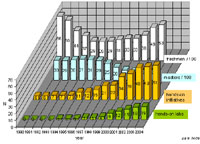 |
| University enrolment and master degrees (“Diplom”) in chemistry in Germany [GDCh]; number of German chemistry hands-on “initiatives” (with temporary or small-group experimental opportunities) and “labs” (permanently open for whole classes and courses). |
In an era of ubiquitous media, entertainment, and advertisement, education has become harder to perform. Many now regard the “hard-core” sciences of chemistry, physics, and mathematics—which seem to require a special degree of concentration, knowledge, and training—as subjects for specialists only. Chemistry in particular has been widely associated with substances that are toxic for humans and the environment. In Germany, this image has contributed to a decrease in the amount of chemistry taught in elementary school.1 At the secondary school level, chemistry classes don’t start before grades 7 or 8, and hands-on experiments for students are less frequent than desired.2 As a result, the number of chemistry freshmen in Germany declined dramatically in the mid–1990s (see figure above). In contrast, the striking interest of children in science phenomena is well known and documented.1 In this context, the hands-on chemistry laboratory teutolab was established at Bielefeld University in 1999 as one of the first of its kind in Germany.
Organization
Teutolab has laboratory space for a class of about 30 students, and age-appropriate equipment for several experimental series. Each series consists of several experimental stations. School classes visit for three to four hours, and the children and youths perform selected experiments from the curriculum, either individually or in groups of two. They are guided by experienced chemistry students are who typically in their third year. Part-time delegated secondary schoolteachers develop the curriculum, supervise the tutors, and form an important communication link between visiting schoolteachers and scientists at the university.
Curriculum
The current teutolab curriculum consists of several series of experiments with age-equivalent levels of complexity, which are shown in the table below as "spiral levels." For example, in the “Natural Products” section, a series of three experiments of increasing difficulty focus on lemons. Elementary school children conducting the Lemon I experiment smell orange oil rubbed from the peel and identify the oily nature of this liquid by splashing droplets into a candle flame. Next, they identify the aqueous juice from the interior of the orange as acidic (“like vinegar”) when drops of this juice turn red cabbage juice red.
Secondary level students (Lemon II and III) extract orange oil from orange peel and citric acid from lemons. They learn to assemble and understand complex experimental setups and procedures and reflect on the differences of “natural” and “chemical” flavors. Also, the individual secondary level groups profit greatly from presenting their lab results to each other at the end of their teutolab activity.
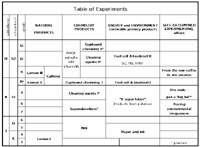 |
Some secondary level experiments are being further developed that will allow high school students to benefit from the equipment available at the university, and from the proximity of the teutolab to cutting-edge research. In addition, experimental series with advanced and special demands are being designed. Thus, advanced students will be asked to experiment with a minimum of guidance—they will work on a problem rather than on a “chemistry recipe.” Furthermore, especially “difficult” issues will be addressed, such as how the mole is the important link between the bulk and the microscopic world. Appropriate hands-on experiments are being developed to address these issues.
Evaluation
It is readily evident to anyone watching the elementary school classes at teutolab that the students are very eager to conduct the experiments and concentrate very hard while performing them. In order to assess the program’s benefits more precisely, the Federal Ministry of Education and Research funded a scientific evaluation of teutolab during its first year. The goals of the evaluation were as follows:
• evaluate students’ motivation and interest
• assess the possibility that schoolteachers could implement the teutolab experiments and teaching style into regular classes
• test alternatives for explaining chemical processes—using animistic or technical terms—to the S1 level (secondary school chemistry beginners) Here, only the first two issues will be discussed. For this, the evaluation research has mostly relied on questionnaires. Videos were taken in addition to document the activities.
Elementary Level Results
The questionnaires for elementary school students and their teachers were distributed and answered after the teutolab visit. More than 2000 fourth grade children were asked about their interests, their motivation to perform experiments, and their feelings and impressions during the teutolab visit; their teachers were asked about their motivation to teach science in their own classroom and factors that might influence their success in doing this.
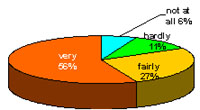 |
| Elementary students were asked if during the experiments, they found that time went by quickly. Overall, more than 80% answered that time went by very or fairly quickly. |
The survey showed an almost 100% positive response to a variety of hands-on activities. Open-ended questions almost always referred to the particular experiments, independent of the actual series performed that day, and showed that the curriculum meets the interest of the children. The figure to the left illustrates how students and teachers regarded the experiments.
 |
| Distribution of scores obtained by elementary school students who had answered questions about equipment used and phenomena observed. |
The chemistry paraphernalia, such as lab coats and goggles, as well as the visit to a university, also made a lasting impression on the students. The figure to the right
shows the degree to which students became
immersed in the experiments. “Feeling like a professor” seemed to be a motivating factor. Over 80% of students said they forgot about time as they concentrated on their work. One of the reasons for this was evidently the good match of the students’ capabilities to the difficulty of the experiments. The students’ answers are mirrored by complementary results from the teachers’ questionnaires (N @ 70).
Part of the children’s questionnaire (N = 710) also contained items referring to knowledge or, more strictly, recollection probability. It was tested whether the 10-year-old children were able to remember equipment they had used and phenomena they had observed. Results show that the intense—however short—teutolab experience does contribute to building knowledge.
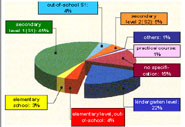 |
| Periods in which chemistry freshmen stated they had their pivotal contact with chemistry (poll of N = 1345 university freshmen, Germany, winter term 2000/2001; S1: grade 5-10, S2: grade 11-13).3 |
These and other results can be regarded as a positive answer to an implicit question that has been raised by a recent poll in Germany (see figure to left): 1345 chemistry freshmen were asked to tell when they had their first pivotal contact with chemistry. Only 7% of the freshmen stated that their first and/or most impressive, decision-making contact with chemistry happened at elementary school age. The poll found that 49% had this contact occur at the S1 level (i.e., grade 7 to 10) and 22% at the pre-school level. Our study shows that the enormous potential of interest in science can well be activated during the elementary school level. Results from the teachers’ questionnaire also explain, however, why this does not happen. The vast majority (around 90%) of the elementary schoolteachers regard their chemical knowledge, as well as the equipment available for science teaching, as insufficient. The teutolab visit motivated about 80% of them to implement simple chemical experiments that reference everyday life, provided—as they state in their responses-that they are supported with training, specific materials, worksheets, and instructions. Secondary Level Results
For the classes of grades 7 and 8, a longitudinal comparative study was designed. Students of 14 classes received questionnaires one week before, one week after, and four months after visiting teutolab. Fourteen additional classes, each of them taught chemistry by the same teacher as the visiting class, served as comparative groups. They were not invited to teutolab during the time period of the study, but had to answer the same questions with respect to interest in chemistry, motivation to perform experiments, and others.
The evaluation of results is still under way. Although the tutors’ subjective impressions of the secondary level students’ motivation were somewhat less positive than for the elementary school children, it turned out that at least the flow effect was almost the same for both levels.
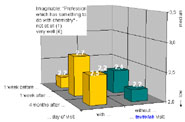 |
| Responses of secondary school students to the question of a future job in chemistry. |
The study also gauged students’ interest in chemistry as a professional occupation (see figure to right). Of course, one cannot expect the majority of 12- to 13-year-old students to choose chemistry as the preferred subject for their entire work life. More interesting is the significant increase in interest among students after they visited teutolab, and the still elevated value four months later. It seems as if conducting experiments with one’s own hands results in a more positive image of chemistry—or eliminates a negative one.
 |
Popularity of school subjects and activities in chemistry classes; grades 11-12. |
These findings are in accord with results from several German studies on the popularity of chemistry as a school subject.2 Chemistry is not very popular (see figure to left), but at least, hands-on experimental activity is appreciated. These results will be discussed briefly in the context of three psychological and didactical issues—the need for self-determination, the image of science among youths, and the worth of hands-on experiments:
• According to the empirically well-established self-determination theory,4 intrinsic motivation (for “doing something because it is inherently interesting or enjoyable”) as well as moderate types of extrinsic motivation (for “doing something because it leads to a separable outcome”) are based on three innate human needs—feeling competent, autonomous, and related to others. With helpful instructions, without time pressure and interfering teachers, and with co-operation of friendly classmates, hands-on experiments are clearly able to fulfill all of these three psychological needs.
• A study of 105 German eighth- and ninth-grade high school students revealed that students who favor science are judged as more unpopular and physically unattractive than any of the other groups (“prototypes”)—students who favor humanities or who explicitly dislike science or humanities.5 On the other hand, students who favor science got the highest scores for intelligence and motivation, whereas those who just dislike science or humanities got the lowest scores. The authors of the study presume that the German type of narrow-focused class work may be responsible for the development of the prototype of a student who is socially incompetent, isolated, and not creative. If this is true, the negative perceptions of science-minded students might be changed by emphasizing discussion and interaction among students through experimental group work as well as personal contact with open-minded scientists (or university students) in a hands-on lab. This would be crucial because the study also suggests that, at least for students with high self-clarity (negative answers to questions like “my beliefs about myself seem to change frequently”), self-to-prototype matching is an important criterion for choosing or avoiding advanced science courses in high school.
• A study from Israel summarizes that, in general, didactical research has failed to show simplistic relationships between laboratory experience and student learning.6 The reasons why hands-on experimental work may fail to yield cognitive skills are presumed to be (i) lack of students’ control of their own learning, (ii) mismatch between teachers’ goals and students’ expectations, (iii) lack of valid tools to assess students’ achievement and progress, and (iv) lack of appropriate professional development for teachers. The study describes the successful introduction of inquiry-type experiments, which give and require students’ control over their learning, into the curriculum of courses for grades 11 and 12. A standardized observation scheme was able to show that extensive teacher training successfully enabled twelve-grade chemistry students to design multi-staged experiments in good alignment with the theoretical questions asked. This example from Israel underlines that, by appropriate hands-on activities, the goal of scientific interest and skill can be reached on a higher secondary level.
Networking Activities
Educational authorities asked teutolab to spread its concept and practice to the schools of the region. A network of more than 20 secondary schools affiliated with teutolab is now able to supply hands-on chemistry experience to a large part of the region’s elementary school children. To this end, the chemistry teachers of the secondary school network obtained equipment and documents as well as a practical introduction to the teutolab program. Typically, four elementary schools in the neighborhood of each secondary school are served. Also, hands-on training for elementary schoolteachers is performed at teutolab, and a set of boxes with material for complete classes has been assembled which can be borrowed by elementary schoolteachers who have completed advanced training at teutolab.
On the state level, educational authorities have been advised to implement more chemistry and experiments into the guidelines for elementary schools. Finally, an “on-tour” program supplies regional public events (festivals, exhibitions, etc.) featuring hands-on chemistry for kids and youths.
On the national level, teutolab integrated information from other hands-on initiatives and labs in Germany (http://pc1.uni-bielefeld.de/~jenett/bmbf/bmbf-mitmlab-d.html) and brought them together for a workshop in February 2004, forming the nucleus of a science education network. Conclusion
Teutolab may serve as a model for how to accomplish the following:
• repopularize the well-known hands-on principle of science education
• stimulate children and young adults to form their own opinions about science
• organize area-wide hands-on classroom activities in a given region
• enhance interactions among schools, university, and educational authorities
Prerequisites for a successful program, such as teutolab, are motivated university faculty, teachers and tutors, private and public sponsors as well as supportive educational authorities. A hands-on lab like the teutolab would not be successful but for the numerous individuals who wish to share their fun and pleasure with science.
References
1. G. Lück, Science in Early Childhood (in German), LIT, Münster (2000)
2. V. Woest, Mathematical-Scientific Education (in German), 50/1, 50-57 (1997)
3. G. Lück, Elementary School (in German) 2002/2, 48-49 (2002); layout: Chemie Report 5/6 (2003)
4. R.M. Ryan and E.L. Deci, Intrinsic and Extrinsic Motivations: Classic Definitions and New Directions. Contemporary Educational Psychology 25, 54-67 (2000)
5. B. Hannover and U. Kessels, Self-to-prototype matching as a strategy for making academic choices. Why high school students do not like math and science. Learning and Instruction 14, 51-67 (2004)
6. A. Hofstein, R. Shore, and M. Kipnis, Providing high school chemistry students with opportunities to develop learning skills in an inquiry-type laboratory: a case study. Int. J. of Sci. Edu. 26, 47-62 (2004).
For more statistical data, see GDCh Gesellschaft Deutscher Chemiker [German Chemists’ Association] (2003): Chemiestudiengänge in Deutschland—Statistische Daten 2002 [Chemistry Study Courses in Germany—Statistical Data]. Frankfurt/Main, 2003 (in German). Part of this articles was presented at the International Symposium on Science Education, Taipei, 25-26 November 2003. The teutolab is at the Faculty of Chemistry at Bielfeld University. The corresponding author, Katharina Kohse-Höinghaus, can be reached by e-mail at <[email protected]>
www.teutolab.de
www.iupac.org/publications/ci/2004/2605/2_teutolab.html
Page
last modified 31 August 2004.
Copyright © 2003-2004 International Union of Pure and
Applied Chemistry.
Questions regarding the website, please contact [email protected]
|